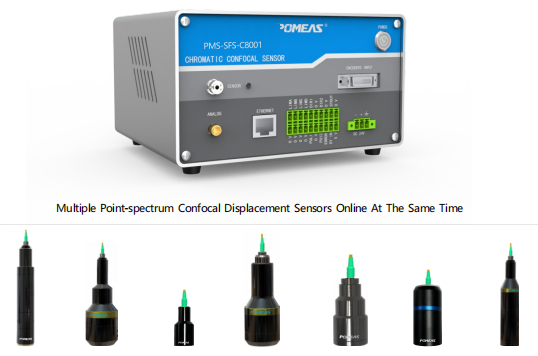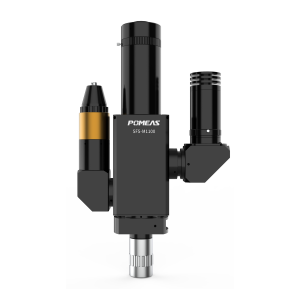Types of spectral confocal sensors:

1. Spot Spectral Confocal Sensors: Spot Spectral Confocal Sensors are mainly used for single-point measurements and can accurately measure a specific position of an object. In 2D inspection, it can recognize surface X/Y axis features such as curvature, roughness, segment difference, etc.. With a special holder, it is also possible to realize double-head thickness measurement in the Z direction.
2. Line Spectral Confocal Sensor: The Line Spectral Confocal Sensor excels in detecting multiple measurement areas and obtaining Z-axis information on the surface of the object under test. It is capable of measuring multiple points on a line simultaneously, making it suitable for in-line full inspection applications and enhancing the inspection beat.
3. Line Array Spectral Confocal Sensors: A line array spectral confocal sensor can be thought of as a series of dot matrix spectral confocal combinations, with every two spectral confocal spots equally spaced apart. It is able to provide measurement data from multiple points on a straight line, further improving the efficiency and accuracy of the measurement.
4. Surface Spectral Confocal Sensors: Surface Spectral Confocal Sensors are capable of measuring multiple points on the surface of an object simultaneously to form a 2D or 3D image, making them suitable for the inspection of complex surfaces. It can provide more comprehensive measurement data to meet advanced inspection needs.
5. Customized solutions: Spectral Confocal Sensors can also provide customized solutions based on specific application scenarios and customer needs. These solutions combine multiple sensor technologies and measurement strategies to meet specific measurement accuracy, speed and stability requirements.


Selection of spectral confocal sensors:
Determine the working range of the probe: Select the appropriate range according to the displacement range of the object to be measured. A range that is too small will make it impossible to measure a wide range of displacements, while a range that is too large may reduce measurement accuracy.
Determine the working distance from the sample to the front of the probe: the reference distance is the distance from the point where the measured value is zero to the front of the probe. It determines the actual measurable range of the sensor. When selecting a model, you need to make sure that the measured object is within the working distance of the sensor.
Consider the appropriate spot size and maximum inclination angle: the spot size affects the resolution and accuracy of the measurement, while the maximum inclination angle determines the sensor's ability to measure inclined surfaces.
Controller selection: Choose the right controller based on factors such as operating frequency, whether encoder triggering is required, and whether multiple channels are needed.
Special application scenarios are considered:
① Mirror surface with large curvature: Prioritize the lens with large angle.
② Rough surface: give priority to large angle, small spot lens.
③ High resolution requirements: such as measuring small gap groove, edge searching, measuring arc height, give priority to large angle, small spot probe.
④ Material thickness measurement: for opaque materials or transparent materials with high precision requirements, it is recommended to use double probe alignment measurement; for transparent materials with high flatness and transparency and low precision requirements, it is possible to use single probe thickness measurement.
⑤ Transparent film thickness measurement: the minimum film thickness should be greater than 1/20 of the measuring range of the probe.
(6) Multi-channel side-by-side measurement: give priority to small diameter probe.
Installation and Environmental Requirements: Ensure that the installation space meets the requirements, and avoid using the sensor in extreme temperature, humidity, vibration and other environments. At the same time, pay attention to the connection and protection of fiber optic patch cords, to avoid bending radius is too small or apply excessive bending stress.
Real-time output requirements: For applications with high real-time output requirements, consider sensors with analog output controllers.
Product recommendation
TECHNICAL SOLUTION
MORE+You may also be interested in the following information
FREE CONSULTING SERVICE
Let’s help you to find the right solution for your project!


 ASK POMEAS
ASK POMEAS  PRICE INQUIRY
PRICE INQUIRY  REQUEST DEMO/TEST
REQUEST DEMO/TEST  FREE TRIAL UNIT
FREE TRIAL UNIT  ACCURATE SELECTION
ACCURATE SELECTION  ADDRESS
ADDRESS Tel:+ 86-0769-2266 0867
Tel:+ 86-0769-2266 0867 Fax:+ 86-0769-2266 0867
Fax:+ 86-0769-2266 0867 E-mail:marketing@pomeas.com
E-mail:marketing@pomeas.com
